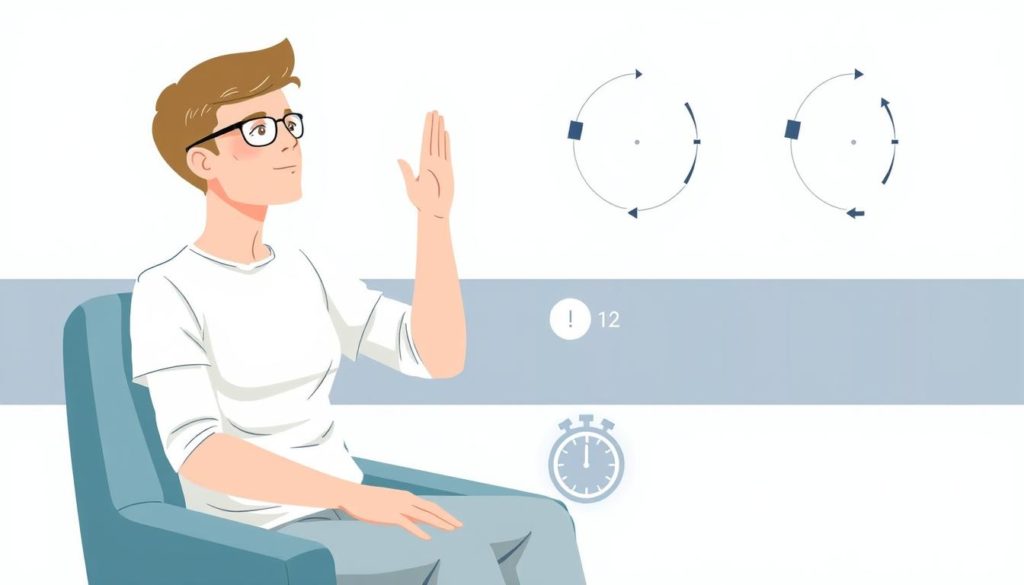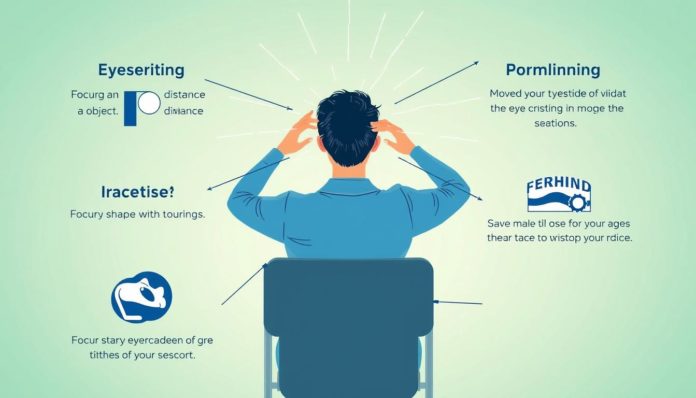Did you know that over 64% of Americans experience symptoms of digital eye strain daily? This fact shows how important it is to improve our vision naturally. Essential eye exercises, also known as vision therapy, can help. They can boost your visual skills and help with eye alignment and focusing issues.
These exercises won’t fix all vision problems, but they can lessen eye strain and help with issues like strabismus (eye turn), amblyopia (lazy eye), and focusing problems. Adding eye relaxation techniques to your daily routine can make your vision better. This might even mean you use glasses less often.
Benefits of Eye Exercises for Vision Improvement
Vision improvement exercises are great for keeping your eyes healthy. They help with symptoms from too much screen time and other eye tasks. Regular practice is key.

Reduce Eyestrain and Fatigue
Eye health exercises are a big help in reducing eye strain and fatigue. Long hours of looking at screens can cause headaches and discomfort. But, simple exercises like palming and eye rolls can ease the strain.
Strengthen Eye Muscles
These exercises also make eye muscles stronger. Just like how workouts tone body muscles, these exercises work on eye muscles. This helps fix issues like lazy eye, making eyes move better together and track objects more accurately.
Improve Focus and Coordination
Eye exercises also boost eye coordination and focus. Doing activities like pencil push-ups and focusing on far-off objects helps improve vision. This means your eyes work better together, making daily tasks easier and more comfortable.
How Often Should You Do Eye Exercises?
Finding the right eye exercise frequency is crucial for the best results. It might seem small at first, but sticking with it is key. Making eye workouts a regular part of your day can really help.

Recommended Frequency
Doing eye workout routines every day is best. Try to do two to three sets of exercises during the day. This can ease eye strain and improve focus over time.
Incorporating Eye Exercises into Daily Routine
Starting a daily eye health routine might seem hard, but it’s about small steps. Begin by setting aside specific times each day for these exercises. This could be during work breaks or as part of your morning and evening routines.
By doing this, you can make eye care a natural part of your day. This leads to better eye health and less strain.
- Morning: Start your day with a simple eye exercise to wake up your vision.
- Afternoon: Take a break from screens and do a quick eye workout.
- Evening: Relax your eyes with a routine before bed for better sleep.
| Time | Exercise | Benefit |
|---|---|---|
| Morning | Palming | Reduces stress and prepares eyes for the day |
| Afternoon | Blinking | Prevents dryness and refreshes vision |
| Evening | Pencil Push-Ups | Improves focus and muscle coordination |
Basic Eye Exercises to Get Started
Starting eye exercises can greatly improve eye health. We’ll explore simple eye relaxation techniques for daily use. These exercises help with immediate relief and long-term eye health.
Palming
Palming is easy and effective. First, warm up your hands by rubbing them together. Then, place your palms over your closed eyes without pressing hard. This relaxes the eye muscles, easing strain and promoting calm. You can do this exercise anywhere, like at work or home.
Blinking
Blinking is key for eye health but often forgotten. Make a point to blink more often to keep your eyes moist and fresh. Take a few minutes each hour to close and open your eyes on purpose. This exercise helps maintain the tear film and prevents dryness from screen time. Blinking is a simple eye exercise to add to your daily routine.
Advanced Vision Improvement Exercises
Advanced eye exercises can greatly improve your vision health. They strengthen eye muscles, boost coordination, and increase flexibility. Pencil push-ups and the figure eight exercises are great for vision therapy.
Pencil Push-ups
Pencil push-ups are great for training your eyes to work together. They help improve three-dimensional vision. Vision therapists often suggest this exercise.
- Hold a pencil at arm’s length away from your eyes.
- Slowly move the pencil toward your nose while keeping your vision clear.
- Then, move it back to arm’s length.
- Do this 10-15 times.
Figure Eight
The figure eight exercise makes eye muscles stronger and improves how your eyes move. You trace a figure eight pattern with your eyes. This boosts coordination and flexibility.
- Picture a large figure eight in front of you.
- Slowly follow the figure eight with your eyes.
- Do this for one minute, then switch directions.
- Do it every day for the best results.
| Exercise | Benefits | Frequency |
|---|---|---|
| Pencil Push-ups | Improves convergence and 3D vision | 10-15 repetitions daily |
| Figure Eight | Enhances muscle strength and flexibility | 1 minute per direction daily |
Using the 20-20-20 Rule for Eye Health
The 20-20-20 rule is a great way to prevent eye strain. It means taking a 20-second break every 20 minutes to look at something 20 feet away. This simple action can help reduce eye discomfort from too much computer use. It’s a key part of computer eye strain relief.
Adding the 20-20-20 rule to your daily life is good for your eye health over time. It helps your eyes focus better by changing their view often. You can also use eye drops, adjust your screen settings, and get regular eye check-ups for more eye strain prevention.
Remembering to take breaks can be easy with a timer on your phone or computer. Every 20 minutes, you’ll know it’s time for a 20-second break. Using the 20-20-20 rule and a well-set workspace can greatly improve your eye health.
| Benefits | Details |
|---|---|
| Reduces Eye Strain | This rule helps ease the stress on your eyes by providing regular breaks. |
| Improves Focus | Shifting your gaze periodically can actually help sharpen focus and reduce fatigue. |
| Encourages Eye Health | Frequent breaks, paired with eye care practices, promote long-term eye health. |
Eye Exercises for Digital Eyestrain
Long hours in front of digital screens can cause eye strain. This can make you uncomfortable and less productive. Doing digital eyestrain exercises can help ease these problems.
Computer Eye Exercises
Here are some easy exercises to fight computer eye strain:
- 20-20-20 Rule: Look at something 20 feet away for 20 seconds every 20 minutes. This helps your eyes refocus and reduces strain.
- Deliberate Blinking: Blink often to keep your eyes moist. This prevents dryness and irritation.
- Palming: Warm your palms and cover your closed eyes with them. This relaxes your eye muscles.
Break Schedules and Ergonomics
Good break schedules and ergonomics are key to reducing eye strain. Setting up your workspace right can make a big difference.
- Regular Breaks: Take a 5-minute break every hour. Use this time for eye exercises.
- Screen Positioning: Make sure your screen is at eye level and 20-30 inches away. This setup reduces the need to constantly refocus.
- Lighting: Use proper lighting to cut down on glare on your screen. Glare is a common cause of eye strain.
Using these strategies daily can improve your eye comfort and health. It helps you stay productive without harming your vision.
The Role of Nutrition in Eye Health
Good nutrition is key for keeping your eyes healthy. Eating foods full of eye health vitamins and nutrients helps prevent vision problems. It also boosts overall eye wellness.
Vitamins and Minerals
Vitamins and minerals are crucial for eye health. Vitamins A, C, E, and zinc fight eye diseases like macular degeneration. Getting enough of these nutrients is vital for good vision.
Food Sources for Eye Health
Adding specific foods to your diet helps your eyes stay healthy. These foods are full of carotenoids, omega-3 fatty acids, and other nutrients good for your eyes. For instance:
- Carrots and sweet potatoes are great for Vitamin A.
- Citrus fruits, like oranges and lemons, are full of Vitamin C.
- Nuts and seeds give you Vitamin E.
- Leafy greens like spinach and kale are packed with carotenoids.
- Fish, especially salmon, is a top source of omega-3 fatty acids.
Common Myths about Eye Exercises
Eye exercises are popular, but many people believe they don’t work well. It’s important to clear up these eye exercise myths. This will help people protect their eye health.
Many think eye exercises can fix problems like myopia or hyperopia. But, they can only help with certain issues, like convergence insufficiency. They don’t replace glasses or surgery for most vision problems.
Some believe eye exercises can solve all eye issues. But, it’s key to know they help eye function, not fix everything. Regular eye exams and advice from eye care experts are still crucial.
“Eye exercises can improve specific conditions but should not be seen as a universal remedy for all vision problems.”
When we want better vision, knowing the facts is key. Let’s avoid eye health debunking myths. Here’s a look at myths versus reality about eye exercises:
| Myth | Reality |
|---|---|
| Eye exercises can replace glasses. | They can’t substitute corrective lenses for refractive errors. |
| All eye issues can be fixed with exercises. | Exercises aid specific conditions, but are not a panacea. |
| No need for eye exams if you do exercises. | Regular eye exams are essential for overall eye health. |
Understanding the truth about these vision improvement misconceptions helps us take better care of our eyes. Always talk to an eye care expert for advice tailored to your needs.
Consulting an Eye Doctor for Personalized Eye Exercises
Getting advice from an eye doctor is key to getting the most out of eye exercises. They can look at your specific needs and create exercises just for you. This way, the exercises you do will really help your eyes, making your vision better.
The eye doctor will check your eyes closely during your visit. They might use special tools to find out what your eyes need. Then, they can give you exercises that fix your specific problems, like reducing eye strain or improving focus.
Doing these exercises every day, with a pro’s help, makes them work better. Getting advice from an eye doctor means you’re doing things right. It also helps your vision get better over time. So, it’s a good idea to see your eye doctor regularly to keep your eyes healthy.
FAQ
What are the benefits of eye exercises for vision improvement?
Eye exercises can lessen eye strain and fatigue. They strengthen eye muscles and boost focus and coordination. These exercises are great for conditions like strabismus, amblyopia, and focusing issues. They also help improve visual skills, which might cut down on the need for glasses.
How often should I do eye exercises?
Doing eye exercises regularly is key to seeing improvements. Make it a part of your daily life by setting aside time each day. This can help with eye strain and focusing problems over time.
What are some basic eye exercises to get started?
Start with simple exercises like ‘palming’ and ‘blinking’. Palming relaxes the eye muscles by covering your eyes with your hands. Blinking helps keep the eyes moist and lubricated.
Are there more advanced eye exercises for better vision?
Yes, there are more advanced exercises like ‘pencil push-ups’ and ‘figure eight’. Pencil push-ups help with convergence and three-dimensional vision. The figure eight exercise boosts flexibility and strengthens eye muscles.
What is the 20-20-20 rule for eye health?
The 20-20-20 rule helps prevent eye strain, especially from computer use. It means taking a 20-second break every 20 minutes to look at something 20 feet away. This helps keep your eyes rested.
How can I combat digital eyestrain with eye exercises?
To fight digital eyestrain, try computer eye exercises like refocusing and blinking breaks. Also, follow a break schedule that includes ergonomics. Make sure screens are at the right distance and angle to prevent eye problems.
What role does nutrition play in eye health?
Nutrition is key for eye health. Vitamins A, C, E, and zinc fight macular degeneration with their antioxidant properties. Eating foods rich in carotenoids, omega-3 fatty acids, and avoiding diabetes and high blood pressure helps eye health too.
Are there any common myths about eye exercises?
Yes, it’s important to clear up some myths. Eye exercises aren’t a fix for all eye problems. They’re best for certain conditions. Always get advice from an eye doctor for the best results.
Should I consult an eye doctor before starting eye exercises?
Yes, talking to an eye doctor is crucial before starting eye exercises. They can customize exercises for you and guide you on how to do them right. This can lead to better eye function and overall eye health.


